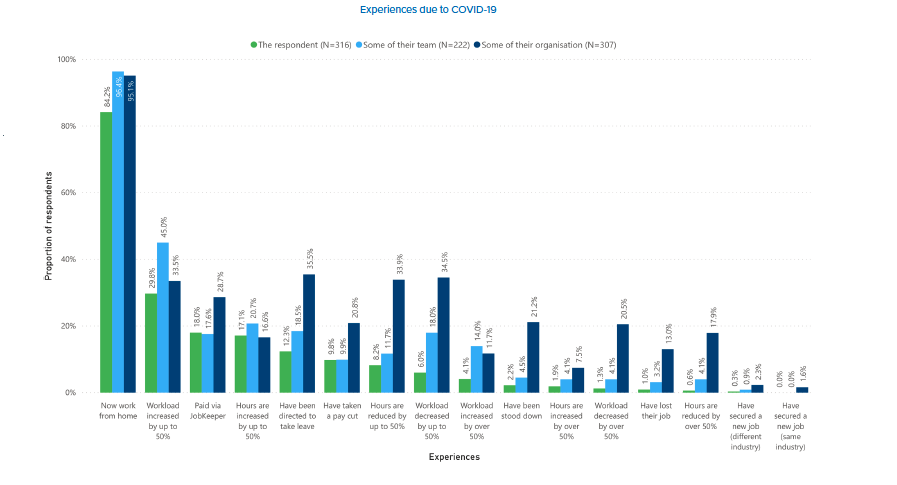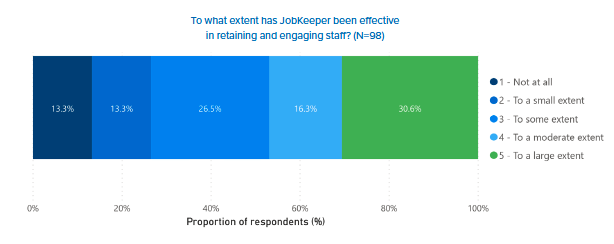AHRI’s latest pulse survey shows HR professionals are burning the candle at both ends and struggling to keep staff connected.
In Australia, COVID-19 is under enough control that lockdowns are continuously easing, but that doesn’t mean HR professionals’ jobs are getting any easier. In fact it means the opposite. Just as the huge move to remote work was unprecedented, so too will be the return to the workplace. For many organisations, this will be the hardest part of the pandemic.
AHRI’s first HR pulse survey – conducted in the first week of April – showed redundancies were a key concern for many HR professionals in Australia. In the second survey, which looks at HR’s sentiments during the first week of May, reintroducing staff into the workforce was respondents’ main concern (66 per cent), followed by loss of revenue (48 per cent) and a downturn in business (47 per cent).
Looking more deeply into the results, it’s clear there are consistent challenges HR professionals are facing right now. Here are the five most important.
1. Workloads have increased but hours don’t reflect this
Nearly 85 per cent of respondents were working from home at the time they took this survey, as were many of their colleagues. So while getting back to the physical workforce might not be a reality just yet, it’s certainly a key item on HR’s agenda.
Formulating a return-to-work plan is time consuming. You have to factor in extra hygiene and cleaning practices, the psychological safety of employees who’ve struggled in isolation and the new legal obligations around social distancing and workplace signage.
So it’s not surprising that 30 per cent of respondents say they’re experiencing a 50 per cent increase in their workload right now, and only 17 per cent say their paid hours are reflective of this.
As one respondent explained it, “[There is] a greater demand on my time to connect with my team and others daily. Balancing home [schooling] of our three kids with a senior role is difficult. I tend to work longer hours and across the weekend to compensate.”

One person said they’ve started having to “play catch up at night” due to their increased workload. They worry that, as a society, we won’t be able to maintain this intense momentum.
“Cracks are going to show. I am working with my managers to [encourage] flexibility and understanding with their people, including me!”
Download AHRI’s latest Pulse Survey report to read the full findings.
2. Maintaining connectedness
Keeping employees connected with the organisation has been a challenge for 42 per cent of respondents.
While many people felt a greater sense of community and closeness during the initial stages of the pandemic – when we were all adjusting to a new reality – it seems that feeling is now waning. Forty-four per cent said that cultivating connectedness is harder now than it was pre-COVID-19.
It could be that the exhaustion from working through a pandemic and communicating in new ways is finally catching up with people.
HRM previously examined video call fatigue and the cognitive dissonance of a hyper-connected environment. This could be causing more people to shut off their video cameras during a call or opt out of virtual social events, therefore weakening the sense of togetherness they felt in the early days of lockdown.
But this isn’t true for everyone. Such social events are a lifeline for a lot of people.
“Some [staff] have openly discussed their surprise at their need for social connection through work – and the surprise factor for them is that pre-COVID they would have said they didn’t need work to provide connectedness,” said one respondent.
This tension between the need for connection and the pitfalls of social technology will be a long-term struggle for workplaces. We know the lines between home and work are easily blurred in a virtual workplace and it’s looking as if many organisations will continue remote working long after the pandemic is over.
3. Returning to work struggles
Understanding how to best reintegrate staff back into the office was a key concern for 66 per cent of respondents, and 39 per cent feel either ‘somewhat pressured’ or ‘pressured’ by their executive team to make this happen.
Nearly 70 per cent feel their staff are somewhat or moderately concerned about the health and safety issues related to the return to the workplace.
As HRM reported earlier this week, a recent survey from the Australian Council of Trade Unions shows that this feeling is widespread. Less than 5 per cent of respondents in that survey said their workplaces had implemented extra cleaning initiatives and less than 10 per cent have been given access to extra personal hygiene products, such as hand sanitizer.
The main metrics which respondents to the AHRI Survey said they were implementing in response to the pandemic were health and safety tracking, pulse surveys and assessing staff preferences on flexible work and return to work plans.
4. JobKeeper struggles
Over a third of respondents say their organisations have signed up for JobKeeper payments. They report that the majority of staff paid under the scheme are likely to keep working their usual hours.
Seventeen per cent of respondents are currently being paid on the wage subsidy themselves.
JobKeeper is proving to be quite helpful in retaining staff, as the graph below demonstrates.

However, HR professionals have some mixed feelings about the government program. A few respondents felt disappointed that they couldn’t support casual staff whose tenure didn’t quite reach the 12 month mark and expatriates.
Others expressed concern about the lifespan of the subsidy, saying they forecast the financial impacts of COVID-19 to go way beyond September (when JobKeeper payments are set to end).
The recent news about the $60 billion JobKeeper miscalculation and nationwide confusion about the application process was also reflected in some of the comments left by respondents.
One person said the administrative and legal aspects of the scheme were an issue for them. Another shared concerns about casual staff not working as many hours as the company needs as they recieve $1,500 each fortnight regardless of hours worked.
5. COVID-19 has shifted HR’s role
There’s both positive and negative reactions to how the pandemic has shifted HR’s role.
Many professionals report feeling overwhelmed with the new set of responsibilities they have to quickly deliver on.
One participant said: “I am under extreme pressure 24/7. Working an average of 70 hour weeks to design, lead and implement changes such as redundancies and contract variations. In addition, I am responsible for formulating communications in these and other areas relating to coronavirus (i.e. leave, and how and when to use it).”
Another person said they’re feeling “lots of pressure to provide the full legal picture with all the issues/responsibilities in a rapidly changing landscape with no time to research. [And we’re] not allowed to utilise external legal advice due to the cost”.
Respondents said they’ve had to re-adjust plans to introduce new HR software. Like the respondent above, others are struggling to balance their normal daily tasks with keeping on top of new employment legislation and updates from Fair Work.
“It has meant my ‘day job’ has almost moved to the side,” said one respondent. “Initially, mobilising our workforce became a full-time role [involving the consideration of] government restrictions, employee health and safety, client experience and business performance. Now the focus is shifting to [managing] how and when to return our staff to the office and what the ‘new normal’ will look like for us.”
One person said the pandemic has resulted in them “reverting back to a more transactional HR” and another said they’re learning how to “manage up” in ways they didn’t have to before.
This is happening in a fraught situation. As one respondent notes, the vulnerability of the job market right now can make it harder to challenge management as there’s a perception that “it’s easier for them to avoid or cut you”.
But it’s not all doom and gloom. Many people have valued the raised profile the pandemic has afforded them. As HRM has said before, this has been a great opportunity for HR professionals to shine and show an organisation exactly what they can do.
As one respondent said, “On the bright side, [COVID-19] has raised the profile of HR, which is a battle I have been trying to address for a number of years. Situation aside, it has been positive for my team to show what we can do to support the organisation.”
Moving forward, the sentiment of respondents was that a successful COVID-19 plan should aim to ensure minimal impacts on productivity and mental health while motivating and engaging employees.
“[I hope] that managers in the business use this time to step up and show leadership, support the business to be resilient and bounce back from where we were/are in a better place,” said a respondent. Organisations, they say, need to be innovative, flexible and responsive to change.


[…] the shift to working from home has actually increased the amount of stress faced by certain professions while increasing the average number of meetings by 13 percent and average workday by 48 […]